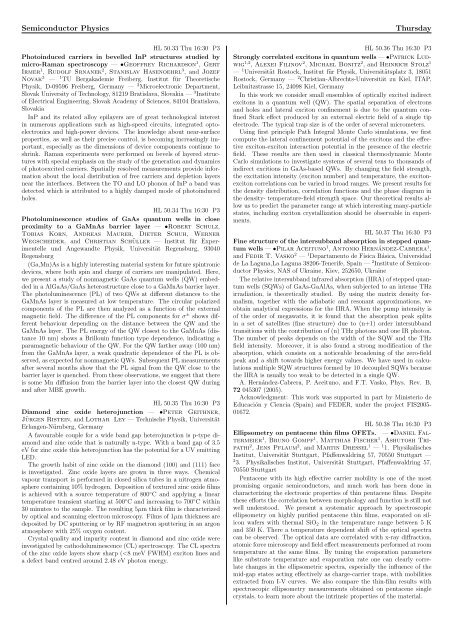HL 50 Poster II - DPG-Verhandlungen
HL 50 Poster II - DPG-Verhandlungen
HL 50 Poster II - DPG-Verhandlungen
Create successful ePaper yourself
Turn your PDF publications into a flip-book with our unique Google optimized e-Paper software.
Semiconductor Physics Thursday<br />
<strong>HL</strong> <strong>50</strong>.33 Thu 16:30 P3<br />
Photoinduced carriers in bevelled InP structures studied by<br />
micro-Raman spectroscopy — •Geoffrey Richardson 1 , Gert<br />
Irmer 1 , Rudolf Srnanek 2 , Stanislav Hasenoehrl 3 , and Jozef<br />
Novak 3 — 1 TU Bergakademie Freiberg, Institut für Theoretische<br />
Physik, D-09596 Freiberg, Germany — 2 Microelectronic Department,<br />
Slovak University of Technology, 81219 Bratislava, Slovakia — 3 Institute<br />
of Electrical Engineering, Slovak Academy of Sciences, 84104 Bratislava,<br />
Slovakia<br />
InP and its related alloy epilayers are of great technological interest<br />
in numerous applications such as high-speed circuits, integrated optoelectronics<br />
and high-power devices. The knowledge about near-surface<br />
properties, as well as their precise control, is becoming increasingly important,<br />
especially as the dimensions of device components continue to<br />
shrink. Raman experiments were performed on bevels of layered structures<br />
with special emphasis on the study of the generation and dynamics<br />
of photoexcited carriers. Spatially resolved measurements provide information<br />
about the local distribution of free carriers and depletion layers<br />
near the interfaces. Between the TO and LO phonon of InP a band was<br />
detected which is attributed to a highly damped mode of photoinduced<br />
holes.<br />
<strong>HL</strong> <strong>50</strong>.34 Thu 16:30 P3<br />
Photoluminescence studies of GaAs quantum wells in close<br />
proximity to a GaMnAs barrier layer — •Robert Schulz,<br />
Tobias Korn, Andreas Maurer, Dieter Schuh, Werner<br />
Wegscheider, and Christian Schüller — Institut für Experimentelle<br />
und Angewandte Physik, Universität Regensburg, 93040<br />
Regensburg<br />
(Ga,Mn)As is a highly interesting material system for future spintronic<br />
devices, where both spin and charge of carriers are manipulated. Here,<br />
we present a study of nonmagnetic GaAs quantum wells (QW) embedded<br />
in a AlGaAs/GaAs heterostructure close to a GaMnAs barrier layer.<br />
The photoluminescence (PL) of two QWs at different distances to the<br />
GaMnAs layer is measured at low temperature. The circular polarized<br />
components of the PL are then analyzed as a function of the external<br />
magnetic field. The difference of the PL components for σ ± shows different<br />
behaviour depending on the distance between the QW and the<br />
GaMnAs layer. The PL energy of the QW closest to the GaMnAs (distance<br />
10 nm) shows a Brillouin function type dependence, indicating a<br />
paramagnetic behaviour of the QW. For the QW farther away (100 nm)<br />
from the GaMnAs layer, a weak quadratic dependence of the PL is observed,<br />
as expected for nonmagnetic QWs. Subsequent PL measurements<br />
after several months show that the PL signal from the QW close to the<br />
barrier layer is quenched. From these observations, we suggest that there<br />
is some Mn diffusion from the barrier layer into the closest QW during<br />
and after MBE growth.<br />
<strong>HL</strong> <strong>50</strong>.35 Thu 16:30 P3<br />
Diamond zinc oxide heterojunction — •Peter Geithner,<br />
Jürgen Ristein, and Lothar Ley — Technische Physik, Universität<br />
Erlangen-Nürnberg, Germany<br />
A favourable couple for a wide band gap heterojunction is p-type diamond<br />
and zinc oxide that is naturally n-type. With a band gap of 3.5<br />
eV for zinc oxide this heterojunction has the potential for a UV emitting<br />
LED.<br />
The growth habit of zinc oxide on the diamond (100) and (111) face<br />
is investigated. Zinc oxide layers are grown in three ways. Chemical<br />
vapour transport is performed in closed silica tubes in a nitrogen atmosphere<br />
containing 10% hydrogen. Deposition of textured zinc oxide films<br />
is achieved with a source temperature of 800 ◦ C and applying a linear<br />
temperature transient starting at <strong>50</strong>0 ◦ C and increasing to 700 ◦ C within<br />
30 minutes to the sample. The resulting 5µm thick film is characterized<br />
by optical and scanning electron microscopy. Films of 1µm thickness are<br />
deposited by DC sputtering or by RF magnetron sputtering in an argon<br />
atmosphere with 25% oxygen content.<br />
Crystal quality and impurity content in diamond and zinc oxide were<br />
investigated by cathodoluminescence (CL) spectroscopy. The CL spectra<br />
of the zinc oxide layers show sharp (

















